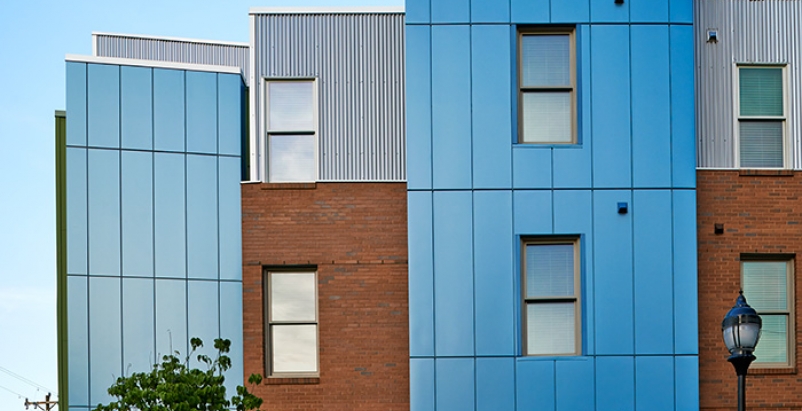
The Northwest Corridor Revitalization Initiative brings together businesses, residents, city authorities, developers, and officials from Johnson C. Smith University (JCSU) to boost the quality of life and economic activity of the Northwest Corridor, a major transportation route from uptown Charlotte, N.C. JCSU opened the vibrant Mosaic Village in the historic West End in 2012 as an important aspect of the revitalization project.
The 124,000-sf mixed-use project contains 80 apartments, accommodating 300 students with numerous amenities. Tenants have access to a gym, computer lab, study rooms, lounges, and a 4,000-sf rooftop terrace. A free shuttle brings riders to the main university campus and uptown Charlotte. Mosaic Village contains 7,500 sf of retail space and was designed to attract new businesses that benefit from this high-density housing. The project strives to promote identity, history, and diversity.
Architect Daniel McNamee was inspired by the neighborhood's rich jazz history and the nearby Excelsior Club, which had at one time been the largest private social club for Black professionals in the Southeast.
“The primary challenge was to take a residence hall—a building type that typically has a lot of overbearing repetition—and compose a dynamic design that tells the story of the historic West End through a connection with jazz music,” said McNamee.
The dynamic and inspiring exterior of Mosaic Village contains a brick façade, with metal panels at varying depths. The panels provide both insulation and a crisp look. They are coated with Valspar's 70% PVDF Fluropon coating in Cool Breakwater Blue and Silversmith, bringing the project to life and providing exceptional protection again the elements.
These dynamic elements helped the project win AIA Charlotte’s Urban Design Merit Award and become a neighborhood favorite, revitalizing the historic neighborhood. - See more at:
http://www.bdcnetwork.com/blog/charlotte%E2%80%99s-mosaic-village-merges-jazz-and-architecture#sthash.yLQ5EXWf.dpuf


Inspired by the area’s rich history and unmatched resilience, Mosaic Village has carefully been sculpted by the cultural influence of Jazz Music, seen and heard at the nearby historic Excelsior Club. The rhythmic progression of the building pulls from the jazz aesthetic and its improvisational yet structured nature. A study of how the layers of music can inform and compose the layers of architecture produces an array of breaks, riffs, vamps, bridges, and improvs in physical form. Following these rules from the realm of jazz, the public and physical realm of Mosaic Village becomes an architectural composition that respects its history, while chartering a new path for the Historic West End Community.
Mosaic Village has been designed as a sustainable campus that promotes diversity, mobility, identity, history, and vitality. The new urban housing development consists of 80 units (299 beds), each with a kitchen, washer/dryer, and 2 bathrooms. Lounges and study rooms are spread throughout each level to promote social interaction, while a fitness room, game room, and computer lab are located at the main lobby.
The village has a goal of sharing resources innovatively, appreciating the individual differences that come with diversity, and celebrating the opportunities for collaboration and engagement involved with being part of the overall mosaic that is Historic West End.
http://neighboringconcepts.com/project/mosaic-village-2/














